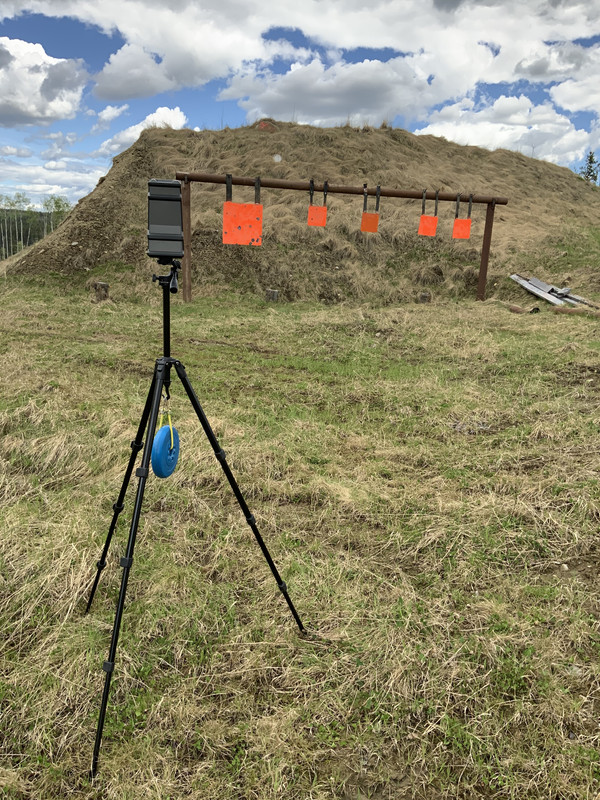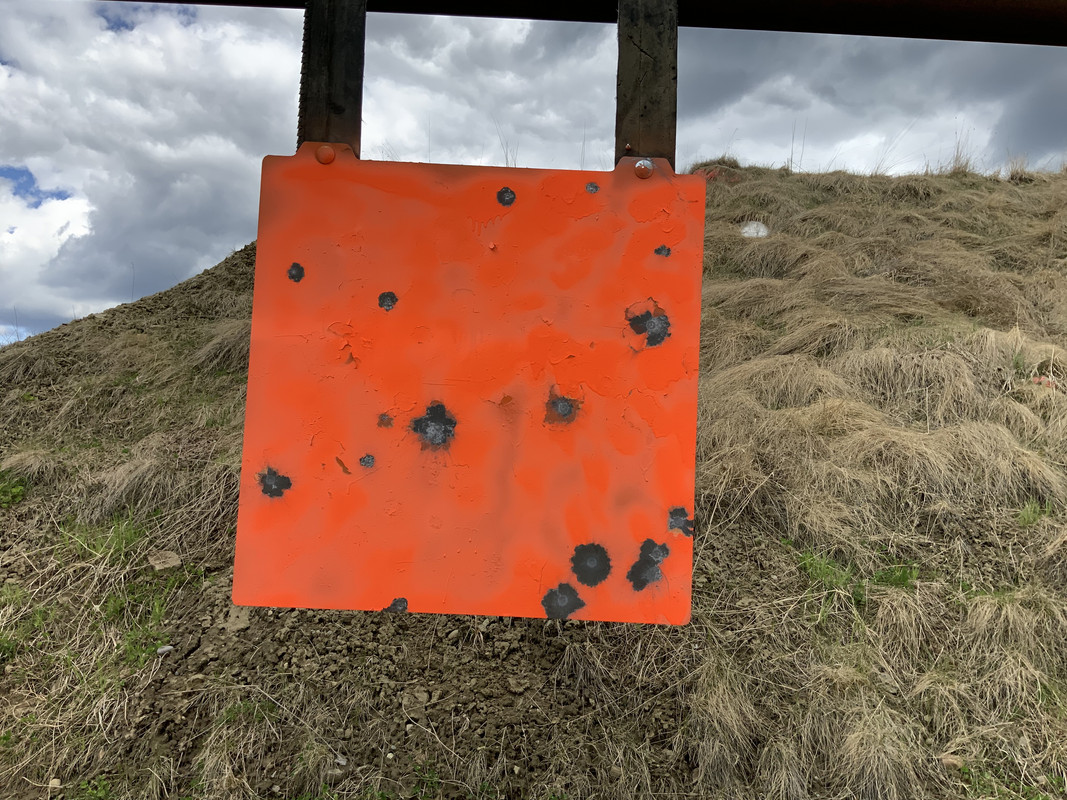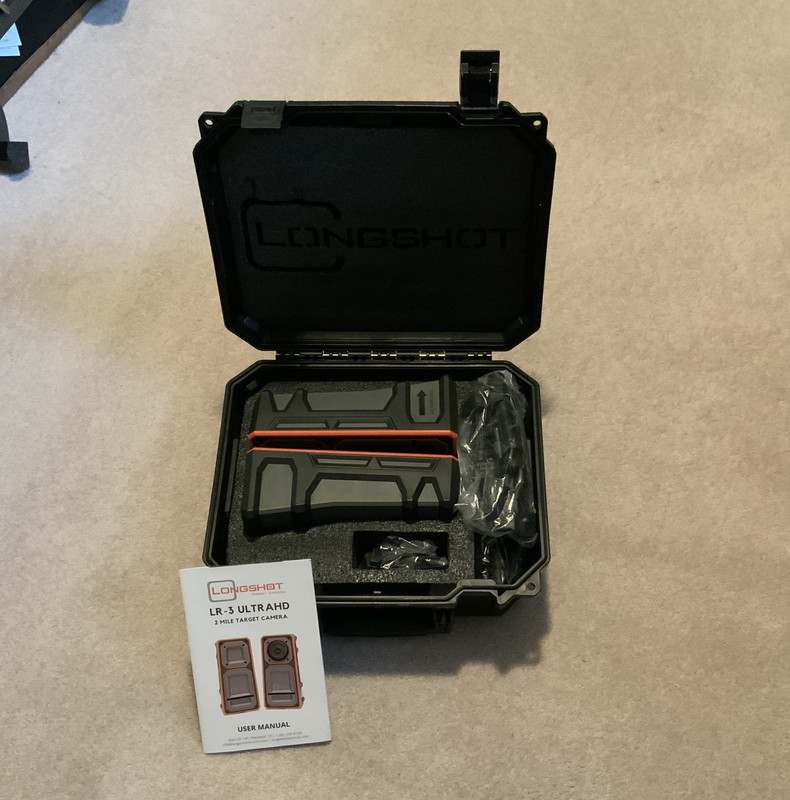I decided that I needed to supplement my LR vision capabilities with a remote camera system. Enter the Longshot LR3 camera system. I tried it out today for the first time. My intention was to see just how it performed at a mile (1600m).
The system consists of two units. The camera and the receiver. The camera transmits its signal to the receiver that you locate at the shooting position. You then acquire both of their ip's and connect on whatever device you use. (Apple or Android.)
It worked great out to 1500m. But because of the terrain, I couldn't set up at the mile (1600m). The targets at the mile stand are elevated about 8 or 9 feet. In fact, I brought a ladder with me to paint them. So when I set up the camera, even on a 5 foot tripod, I couldn't see back to the shooting position because of the "dip" I found myself in. Strictly a terrain issue. Now, I didn't feel like travelling all the way back to see if the receiver could "see" the camera. So I made the decision to test it at 1500m instead. No such issues at 1500m. I had 2 rifles with me. A 6.5x47L and a .338LM.
Here's the set-up in front of the 1500m target stand.

The picture resolution is wonderful. I found myself pulling the trigger and glancing left to look at the iPad. I could even see misses. In fact, the APP labelled the misses.
With the 6.5x47L round, seeing hits past 1000m (let alone 1500m) were impossible. With or without mirage. The .338LM is a different story. But the mirage made things tough. There was a fellow that spotted for me. He had a high end (Vortex, I believe) spotting scope. And even he had a tough time seeing the shots today. (Oh, and throw in some wind, and things were pretty interesting today.)
Here's a captured image where you can really tell the difference in the two caliber's sizes.

The video is pretty cool too. The magnum moves the steel pretty good. Even at that distance. Watching the hit and then the steel swing is really cool. The smaller caliber did not move that large piece of metal at all.
Now, I set up according to the instructions. I made sure the camera unit had a line of sight back to the shooting position. This makes for some strange angles. In other words, I felt uncomfortable setting it up directly in front of the target that I was going to shoot. I eventually figured out an offset angle that I was comfortable with and still let the unit's back (antenna) point back to the shooting position. EDIT: I just remembered that the camera lens is adjustable. So I could have set the camera further offset to the target. (Getting old is a b1itch!)
When I got back to the shooting position, I set up the receiver. The signal was full scale (strong). It took all of a minute to scan the ip's and get a picture. Impressive at 1500m.
Like I said above, I found myself glancing left to look at the iPad on a lot of shots. Since the distance made for a pretty long transit time for the bullet, I could time my look over to the screen and see my hits and misses in the grass. How cool is that?
I had the two units turned on (both with a full charge) for 3 hours. The battery level indicator only dropped 1 LED out of 4 in that time. So, it looks like the battery life is pretty good too.
Now, there is a dislike about the system. And that's the APP that you use. It is "clunky" and not very intuitive. The instruction booklet that comes with the unit doesn't give much help in trying to figure out how to save and file pictures and video. The shot above, of the target, is a screen shot I did from my iPad of the camera view just before I finished for the day. Thank goodness I did that because while trying to edit an album that had the picture "captures" in, I deleted all of the stills. Crap! Well, at least I still have 8 or 9 video sequences saved.
So all in all, a great addition to any LR shooter's kit. The terrain issue at the mile was frustrating. I hope to try it out later this summer to 2600 yards (a mile and a half). That location is very flat and there shouldn't be any terrain issues there. Price wise, it is expensive. The two units do appear pretty robust. The 2 tripods that are supplied with the kit are adequate. But I elevated the camera at the target for optimal signal strength with my own tripod. Since the berms and terrain probably would have given some signal strength issues back to the shooting position if I would have used the small tripod near to the ground. And the whole kit comes with a hard lockable plastic case that has cut outs provided for all of the pieces.

My greatest "like" of the whole system is being able to see the hits. Almost in real time too. At 1500m, a 6.5x47L round takes some time to reach the target. I found myself glancing left after I broke the trigger to watch the shot. Seeing the misses in the grass too, is so cool! Without the camera, you would never see that kind of a miss in grass at that distance. I could then make my adjustments. Although wind doping at that distance with that "little" round can be an adventure.
My score: a 7.5 out of 10. And only because of that silly APP.
The system consists of two units. The camera and the receiver. The camera transmits its signal to the receiver that you locate at the shooting position. You then acquire both of their ip's and connect on whatever device you use. (Apple or Android.)
It worked great out to 1500m. But because of the terrain, I couldn't set up at the mile (1600m). The targets at the mile stand are elevated about 8 or 9 feet. In fact, I brought a ladder with me to paint them. So when I set up the camera, even on a 5 foot tripod, I couldn't see back to the shooting position because of the "dip" I found myself in. Strictly a terrain issue. Now, I didn't feel like travelling all the way back to see if the receiver could "see" the camera. So I made the decision to test it at 1500m instead. No such issues at 1500m. I had 2 rifles with me. A 6.5x47L and a .338LM.
Here's the set-up in front of the 1500m target stand.

The picture resolution is wonderful. I found myself pulling the trigger and glancing left to look at the iPad. I could even see misses. In fact, the APP labelled the misses.
With the 6.5x47L round, seeing hits past 1000m (let alone 1500m) were impossible. With or without mirage. The .338LM is a different story. But the mirage made things tough. There was a fellow that spotted for me. He had a high end (Vortex, I believe) spotting scope. And even he had a tough time seeing the shots today. (Oh, and throw in some wind, and things were pretty interesting today.)
Here's a captured image where you can really tell the difference in the two caliber's sizes.

The video is pretty cool too. The magnum moves the steel pretty good. Even at that distance. Watching the hit and then the steel swing is really cool. The smaller caliber did not move that large piece of metal at all.
Now, I set up according to the instructions. I made sure the camera unit had a line of sight back to the shooting position. This makes for some strange angles. In other words, I felt uncomfortable setting it up directly in front of the target that I was going to shoot. I eventually figured out an offset angle that I was comfortable with and still let the unit's back (antenna) point back to the shooting position. EDIT: I just remembered that the camera lens is adjustable. So I could have set the camera further offset to the target. (Getting old is a b1itch!)
When I got back to the shooting position, I set up the receiver. The signal was full scale (strong). It took all of a minute to scan the ip's and get a picture. Impressive at 1500m.
Like I said above, I found myself glancing left to look at the iPad on a lot of shots. Since the distance made for a pretty long transit time for the bullet, I could time my look over to the screen and see my hits and misses in the grass. How cool is that?
I had the two units turned on (both with a full charge) for 3 hours. The battery level indicator only dropped 1 LED out of 4 in that time. So, it looks like the battery life is pretty good too.
Now, there is a dislike about the system. And that's the APP that you use. It is "clunky" and not very intuitive. The instruction booklet that comes with the unit doesn't give much help in trying to figure out how to save and file pictures and video. The shot above, of the target, is a screen shot I did from my iPad of the camera view just before I finished for the day. Thank goodness I did that because while trying to edit an album that had the picture "captures" in, I deleted all of the stills. Crap! Well, at least I still have 8 or 9 video sequences saved.
So all in all, a great addition to any LR shooter's kit. The terrain issue at the mile was frustrating. I hope to try it out later this summer to 2600 yards (a mile and a half). That location is very flat and there shouldn't be any terrain issues there. Price wise, it is expensive. The two units do appear pretty robust. The 2 tripods that are supplied with the kit are adequate. But I elevated the camera at the target for optimal signal strength with my own tripod. Since the berms and terrain probably would have given some signal strength issues back to the shooting position if I would have used the small tripod near to the ground. And the whole kit comes with a hard lockable plastic case that has cut outs provided for all of the pieces.

My greatest "like" of the whole system is being able to see the hits. Almost in real time too. At 1500m, a 6.5x47L round takes some time to reach the target. I found myself glancing left after I broke the trigger to watch the shot. Seeing the misses in the grass too, is so cool! Without the camera, you would never see that kind of a miss in grass at that distance. I could then make my adjustments. Although wind doping at that distance with that "little" round can be an adventure.
My score: a 7.5 out of 10. And only because of that silly APP.
Last edited:


